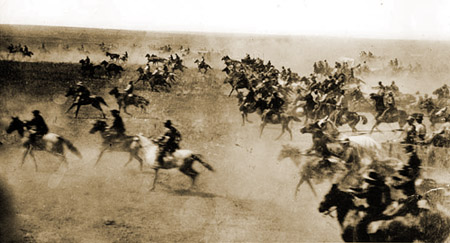Boomer! Sooner!
With the bang of gun at high noon on April 22, 1889, an estimated fifty thousand people began what is now known as the Land Rush of 1889. Cleveland County was originally occupied by the Quapaw, which ceded the area to the federal government soon after the Louisiana Purchase in 1818 and their forced removal.
During the late 1820s and 1830s, the area was given to the Creek and Seminole after their forced removal from the southeastern United States. An agreement between the two tribes resulted in this area being part of the Seminole Nation, located west of the Creek Nation. In 1866, these tribes were forced to cede the area to the federal government for siding with the Confederacy during the Civil War. The area became part of the Unassigned Lands which was opened for white settlement in the Land Rush of 1889.
These individuals were battling for a piece of the American Dream: each legal entrant (the head of a family) could claim up to 160 acres of the two million acres of land which included all or part of the present day Canadian, Cleveland, Kingfisher, Logan, Oklahoma, and Payne counties of Oklahoma. Ownership of the land would be transferred after five years of continuous residence and improvement to the land, pursuant to the Homestead Act of 1862.
Of course, there were those who illegally enterd early to lay claim to choice lands known as "Sooners." As for the "Boomers", they were those individuals who initially campaigned the federal government to open up the Unassigned Lands for homesteading.
Where settlers built towns and broke the sod for farms, earlier Spanish and French explorers likely marveled at variety of terrain within the boundaries of Oklahoma. Colonel A. P. Chouteau established a trading post near Lexington, and Jesse Chisholm established another famous trading post. Washington Irvin, author of Rip Van Winkle and Legend of Sleepy Hollow, killed a buffalo in the vicinity of present day Moore and wrote about it in A Tour on the Prairies. Approximately twenty sites in the county are listed on the National Register of Historic Places.
After the passage of the Organic Act in 1890, Cleveland County was organized as County 3 and Norman became the county seat. For a short time initially, Cleveland County was known as Little River County until an election in 1890. The voters selected the name Cleveland in honor of President Grover Cleveland over the name Lincoln.
Oklahoma's segregation laws were fought in Cleveland County by Ada Lois Sipuel Fisher with the help of a young Thurgood Marshall, who was later the first African-American United States Supreme Court Associate Justice. Years after Ada Fisher initiated the end of higher education segregation in Oklahoma, Governor David Walters symbolically righted the wrongs of the past by appointing her to the Board of Regents of the University of Oklahoma, the same school that had once refused to admit her to its College of Law.
Early settlers established higher education facilities in the county. In 1890, High Gate Female College was opened, which was Oklahoma's first college. Two years later, the University of Oklahoma opened.
The first people in Oklahoma likely came twelve thousand years ago from Asia, across a land bridge to what is now Alaska, before traveling southeast. Fifty-eight archeological sites have been identified in Cleveland County, of which four are of the Paleo era (prior to 6000 B.C.), thirty-eight of the Archaic era (6000 B.C. to A.D. 1), ten of the Woodland era (A.D. 1 to 1000), and six of the Plains Village era (A.D. 1000 to 1500). One identified site is the Thunderbird Dam Site, circa 500 B.C. to 1000 A.D. Artifacts recovered include dart and arrow points and cord-marked pottery.




